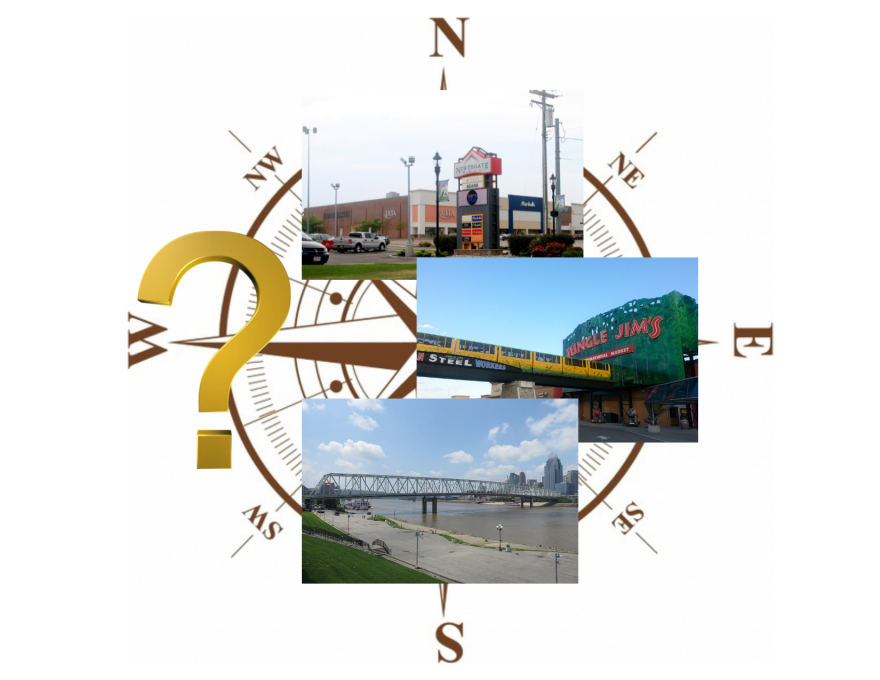Our feature OKI Wanna Know tackles those questions everyone wonders about, but few dare to ask. This week, WVXU's Bill Rinehart looks at some landmarks with cardinal names, and a missing directional.
John Beiting of Fort Thomas has a question he says has boggled his mind for years: "In the Greater Cincinnati area, we've got an Eastgate, we have a Northgate, and even down in Kentucky we have Southgate. Why is there no Westgate?"
The answer may lie in how those three "-gates" got their names.
Southgate
Southgate Mayor Jim Hamberg says his community was officially incorporated on May 2, 1907, but had been growing for about 50 years before that.
"A lot of people think that we are the south gate of Newport, which is not the case. There was actually a Southgate family, another reason we have the Taylor-Southgate Bridge, as explained by General Taylor's involvement here too, as well."
General James Taylor is recognized as the founder of Newport. Richard Southgate moved to Newport in 1795 and became the Campbell County commonwealth attorney three years later, and the town is named in his honor. Mayor Hamberg says the family name came about because they were the protectors of the south gate of London, England.
Eastgate
Eastgate isn't so well documented, according to Cindy Johnson with the Clermont County Historical Society. She says it appears David Este had a farm in what would be referred to as Glen Este. He also ran the post office and a train depot with a sign declaring "Welcome to the east gate of Cincinnati."
"Eastgate kinda moved a little further east and when they put up the mall, they named it Eastgate after that, is the rumor," Johnson says. "But it works for me. You hear stories that you feel like are made up somewhere along the line, but because he was involved in the railroad, they would have a sign 'Welcome to the east gate of Cincinnati' as kind of a promo."
Northgate
After World War II, the Cincinnati area, like the rest of the country, started to grow and look more like what we see today. Dan Hurley, founder of Applied History Associates, says the tendency was to rename things as they got developed. That renaming includes two other local "gates" -- including Northgate.
"What the exact origins of that term are, I do not know," he says. "What I do know is that the Northgate Shopping Mall - which opened in 1972, and certainly used the name at that point - prior to that that site was what was known as the Mount Healthy Airport."
Northgate is now a Census Designated Place, which is something the Census Bureau marks for statistical purposes. Before it was defined for the Census, and before the mall was built, Hurley says most people living in what we call Northgate would have referred to the area as Bevis or Peach Grove.
He suspects the Northgate name is a commercial invention.
"And just as the West End, which was was torn down to build I-75 and the light industrial park was named Queensgate, that was a name that was developed by a marketing company to sort of obliterate what had been done to the old West End, which had a real history, and displaced 40,000 people," he says. "They wanted to clean it up and make it cute. I suspect Northgate is also a marketing term that was just imposed and does not have much historical roots to it."
So... Why no 'Westgate'?
Hurley says his marketing theory can be backed up by the lack of a big indoor shopping center on the west side.
While there isn't a neighborhood or even a mall named Westgate, Cincinnati does have a Westgate Avenue. But it's on the east side. It's off of I-71, between Dana and Smith Road.
Update: @snarkymom428 pointed out on Twitter there was an indoor mall on the west side.
"Western Hills had an indoor mall. It was called Western Woods Mall and was open until at least (19)90."
Western Hills had an indoor mall. It was called Western Woods Mall and was open until at least 90
— SkepticOptimist #HousePfizer (@snarkymom428) November 10, 2021
Have a question you'd like answered? Submit it below and we may answer it in a future episode.




